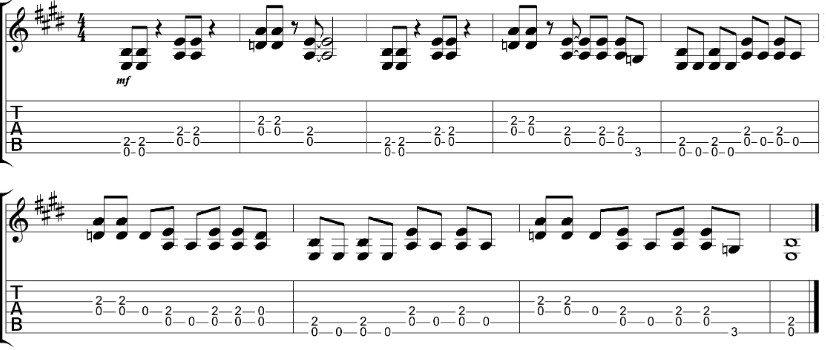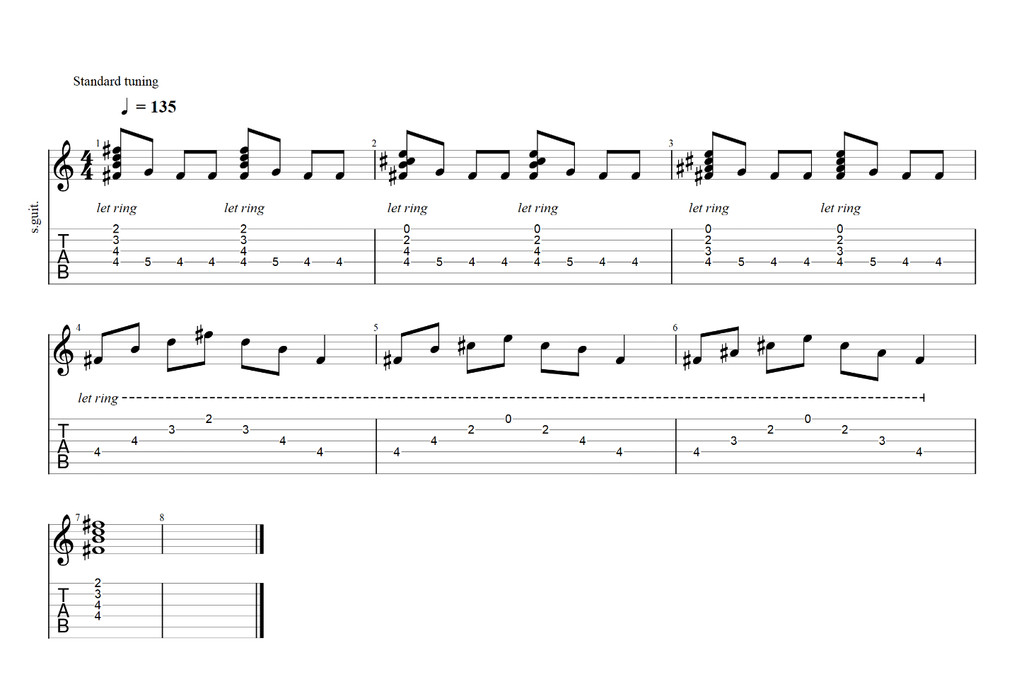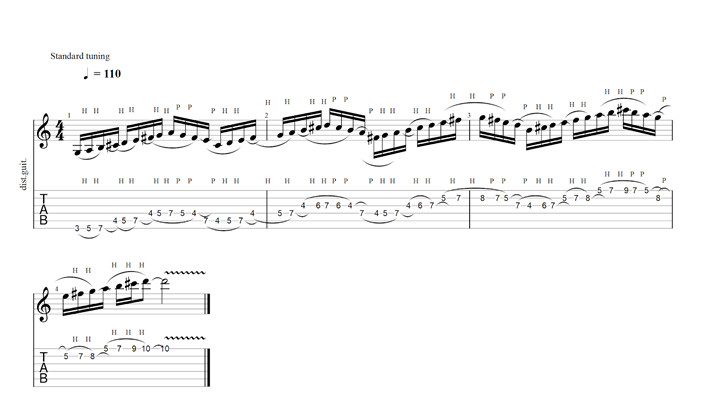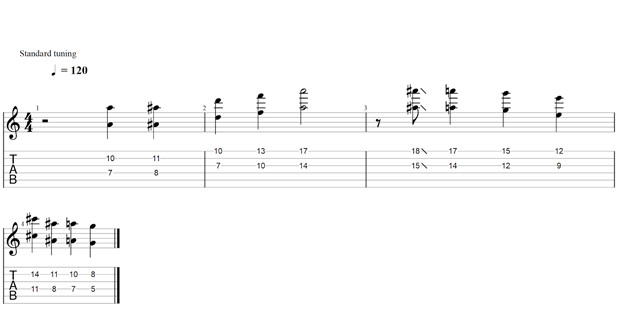Welcome back to guitarplayers.net! Today, we’re diving into a fundamental aspect of guitar playing and songwriting: guitar riffs. It’s surprising how many guitarists struggle to clearly define or differentiate between riffs and licks. If you’re in that boat, don’t worry – you’re definitely not alone. Understanding these concepts is crucial for composing your own music and effectively communicating musical ideas with other musicians.
This lesson aims to clarify the definition of a guitar riff and distinguish it from a guitar lick. We’ll explore what makes riffs so important and provide examples to solidify your understanding. Get ready to sharpen your musical vocabulary and enhance your guitar knowledge!
 A guitarist playing a red electric guitar, focusing on the fretboard, illustrating the action of playing guitar riffs
A guitarist playing a red electric guitar, focusing on the fretboard, illustrating the action of playing guitar riffs
Throughout this article, we’ll reference iconic guitar riffs and licks, and provide tablature examples so you can learn and play them yourself. To truly grasp the nuances, I highly encourage you to listen to recordings and watch videos of the original songs. This will help you understand the feel and context of each musical phrase.
So, let’s embark on this journey to demystify riffs and licks once and for all!
What Exactly is a Guitar Riff?
Let’s cut to the chase: a guitar riff is the signature musical phrase of a song. It’s a short, repeated musical idea that acts as the backbone and often the most recognizable element of a track. Think of it as the central theme, the hook that grabs your attention and sticks in your head. Guitar riffs are typically introduced early in a song, often in the intro, immediately establishing the song’s character and vibe.
Consider the legendary intro to Guns N’ Roses’ “Sweet Child O’ Mine.” This is not just an intro; it is the song’s identity. It’s a prime example of a classic guitar riff – instantly recognizable and integral to the song’s success. That, in its essence, is what we Define Guitar Riff to be.
 Close-up of guitar fretboard with fingers pressing strings, demonstrating guitar riff playing technique
Close-up of guitar fretboard with fingers pressing strings, demonstrating guitar riff playing technique
The Power of the Guitar Riff: Why Are Riffs So Important?
A well-crafted guitar riff elevates a simple song, transforming it into something truly memorable and impactful. This recurring musical theme is generally consistent throughout the song, acting as a sonic anchor, immediately signaling to the listener what song they are hearing.
Imagine trying to play Led Zeppelin’s “Stairway to Heaven” with a completely different opening – it simply wouldn’t work. The iconic opening riff is the song’s soul, its defining characteristic. Similarly, removing the powerful riff from Deep Purple’s “Smoke on the Water” would instantly diminish the song’s impact. These famous guitar riffs are not just musical phrases; they are the very essence of the songs they belong to.
Guitarists around the globe have harnessed their creativity to compose riffs that have topped charts and remained iconic for decades. These riffs are the foundation upon which entire genres are built and are essential learning material for any aspiring guitarist.
Must-Know Guitar Riffs: A Starting Point
Here are some iconic guitar riffs you absolutely should explore (we’ll mention more later):
- “Voodoo Child (Slight Return)” – Jimi Hendrix
- “Beat It” – Michael Jackson (featuring Eddie Van Halen)
- “Alphabet Street” – Prince
- “No One Knows” – Queens of the Stone Age
- “Killing In the Name” – Rage Against the Machine
- “Satisfaction” – The Rolling Stones
- “Seven Nation Army” – The White Stripes
- “Hero” – Skillet
Guitar Riff: In Conclusion
Hopefully, you now have a solid understanding of what a guitar riff is. It’s the heart and soul of a song, establishing its musical identity and often appearing in the introduction. However, riffs aren’t limited to intros; you can strategically place them throughout your compositions to enhance impact. The key is that a riff is a concise, memorable musical phrase that defines your song and elevates its overall impact.
Importantly, guitar riffs are generally not improvised. They are composed and intentionally repeated. No one would suggest improvising over the “Voodoo Child” riff because changing it would fundamentally alter the song’s identity.
Now, let’s shift our focus to guitar licks and explore how they differ from these foundational riffs.
What is a Guitar Lick? Exploring Guitar Licks Definition
Let’s be clear: when we talk about a guitar lick, we’re definitely not talking about physically licking your guitar! While some rock stars might do that for show, musically, a guitar lick is something completely different.
Unlike a guitar riff, which is a fixed and defining element of a song, a guitar lick is a short, melodic phrase often used for improvisation or to add flair to a solo. Guitar licks are more flexible and are meant to be varied. You might hear licks referred to as fills, runs, or even solos – the common thread is their improvisational and ornamental nature.
 A guitarist playing a guitar solo, showcasing the improvisational nature of guitar licks
A guitarist playing a guitar solo, showcasing the improvisational nature of guitar licks
Why Play Guitar Licks? The Purpose of Licks
Guitarists often use licks to inject personality and excitement into their playing, especially during solos. In live performances, guitarists frequently improvise, adding variations and spontaneous musical ideas. These improvisations often manifest as licks – short, expressive phrases that deviate slightly from the main melody.
However, not every improvised phrase qualifies as a lick. A true guitar lick is designed to be reusable, a musical idea that can be incorporated into multiple songs and solos with slight modifications. A guitarist might alter a lick by changing a note, rhythm, or adding embellishments. Because licks have a defined structure, they are learnable and transferable, allowing guitarists to expand their vocabulary and add expressive flourishes to their playing. Learning guitar licks is a fantastic way to enhance your soloing skills and musical expression.
In the following sections, we’ll examine classic examples of both riffs and licks to further illustrate their differences and how they are applied in music. Remember the core distinction: riffs are fixed and foundational, while licks are flexible and improvisational.
Riff vs. Lick: Key Differences Summarized
Just to ensure absolute clarity, let’s reiterate the key differences between guitar riffs and licks. If you skipped ahead, this is the essential takeaway!
We’ve established that a riff is a unique, repeated, and attention-grabbing musical phrase. It’s the sonic fingerprint of a song, defined by its rhythm, melody, and harmonic structure. Riffs can appear anywhere in a song, but are frequently used in introductions to immediately establish the song’s identity. A well-executed riff is instantly memorable and creates a strong connection with the listener.
On the other hand, a lick is a more fleeting musical idea, used to embellish and add variety to a song, particularly during solos or fills. Licks are about improvisation and showcasing individual skill.
 Infographic comparing guitar riffs and licks, highlighting key differences in purpose, repetition, and improvisation
Infographic comparing guitar riffs and licks, highlighting key differences in purpose, repetition, and improvisation
A riff is self-contained and complete. Playing the intro riff to Metallica’s “Nothing Else Matters,” for example, is musically satisfying even on its own. A lick, however, played in isolation, would likely sound incomplete and lack context. It needs the surrounding musical landscape to make full sense.
While riffs are versatile and can be adapted for various instruments, licks are more guitar-centric, emphasizing guitaristic techniques and phrasing. Riffs set the overall vibe and foundation, while licks highlight a guitarist’s skill and improvisational abilities. Riffs are designed for memorability and lasting impact, whereas licks are more about momentary brilliance and improvisation.
Analogy: Think of baking a cake. The icing is the riff – it’s what makes the cake visually distinctive and adds a signature flavor. The cake feels incomplete without it. Licks are like sprinkles or other decorative elements – they are nice additions, adding texture and visual appeal, but not essential to the cake’s fundamental character or flavor.
The most crucial distinction remains improvisation. Licks are inherently improvisational and adaptable. Riffs are intentionally composed musical ideas, integral to the song’s structure, not spontaneous improvisations.
Guitar Riffs V/s Licks (Infographic Summary)
[See the infographic above for a visual summary of the differences.]
15 Must-Listen Memorable Guitar Riffs
Earlier, we touched upon a few iconic riffs. Now, let’s expand that list with more examples of truly exceptional riffs that every guitarist should experience for inspiration. Many of these are frequently cited among the greatest guitar riffs ever created.
To truly appreciate the power of a riff, try to imagine each song without its signature riff. You’ll quickly realize how essential the riff is to each song’s identity and impact. Get ready to discover some new additions to your playlist!
 A collection of vinyl records and a guitar, representing a diverse range of musical styles and guitar riffs
A collection of vinyl records and a guitar, representing a diverse range of musical styles and guitar riffs
Note: This list is in no particular order.
- “Brianstorm” – Arctic Monkeys
- “Johnny B. Goode” – Chuck Berry
- “Paranoid” – Black Sabbath
- “Sunshine of Your Love” – Cream
- “One” – Metallica
- “Back in Black” – AC/DC (Often cited as the greatest guitar riff of all time)
- “Pretty Vacant” – Sex Pistols
- “I Wanna Be Your Dog” – The Stooges
- “I Can’t Explain” – The Who
- “Cinnamon Girl” – Neil Young
- “Don’t Cry” – Guns N’ Roses
- “Marquee Moon” – Television
- “Get It On” – T. Rex
- “Alive” – Pearl Jam
- “Smells Like Teen Spirit” – Nirvana
Beginner-Friendly Guitar Riffs to Learn at Home
Now it’s your turn to put theory into practice! Let’s grab your guitar and explore some riffs you can learn and master. The following riffs are designed to be beginner-friendly, so you don’t need to be a guitar virtuoso to play them. Regardless of your skill level, if you know basic chords and techniques, you should be able to tackle these riffs with some practice.
As you practice these riffs, feel free to experiment with them in your own songs or modify them to suit your style. The goal is to build your riff vocabulary and get comfortable creating your own musical phrases.
 A close-up of hands playing power chords on an electric guitar, demonstrating beginner-friendly guitar riffs
A close-up of hands playing power chords on an electric guitar, demonstrating beginner-friendly guitar riffs
Power Chord Guitar Riff for Beginners
This riff utilizes power chords and is highly versatile. It’s an excellent practice pattern and can be adapted for your own songs with minor tweaks. Palm muting enhances the heaviness of this riff, though it’s optional. If you’re unfamiliar with palm muting, there are numerous online tutorials to guide you.
 Guitar tablature for a beginner power chord riff in E5, A5, and D5
Guitar tablature for a beginner power chord riff in E5, A5, and D5
This riff uses E5, A5, and D5 power chords. You can integrate it into various song sections, such as the chorus, ensuring it complements the song’s overall structure.
Funky Clean Guitar Riff for Practice
Funky riffs are universally appealing! This riff is designed to help you explore a cleaner, funkier style. For this riff, try using your thumb on your neck hand to mute strings – a technique that provides accurate and convenient muting effects.
Unlike the power chord riff, this funky riff is designed for repetition in song verses.
 Guitar tablature for a funky clean guitar riff, emphasizing rhythmic and muted notes
Guitar tablature for a funky clean guitar riff, emphasizing rhythmic and muted notes
Transpose this riff to G for subsequent bars to create variation. This pattern works well in verses and can be modified to fit different song sections.
Acoustic Guitar Riff for Introduction
 Acoustic guitar player, highlighting acoustic guitar riffs for song introductions
Acoustic guitar player, highlighting acoustic guitar riffs for song introductions
Acoustic guitarists, we haven’t forgotten you! There’s a wealth of fantastic acoustic riffs to explore.
Here’s a great example of an acoustic guitar riff perfect for introductions. It’s a concise yet effective riff that immediately sets the tone and tempo of a song. This riff is typically played once in the introduction to establish the song’s character.
 Guitar tablature for an acoustic guitar riff suitable for song introductions
Guitar tablature for an acoustic guitar riff suitable for song introductions
Guitar Licks to Practice at Home
Of course, alongside riffs, we must explore licks! Let’s examine a couple of licks to learn and incorporate into your playing.
 A guitarist practicing guitar licks, focusing on speed and dexterity
A guitarist practicing guitar licks, focusing on speed and dexterity
Guitar Lick in the Style of Joe Satriani
Joe Satriani is a name synonymous with incredible guitar licks. He’s renowned for his technical prowess, expressive playing, and distinctive compositional style. His performances are inspiring and his style is highly sought after by guitarists.
Here’s a lick inspired by Satriani’s style, incorporating some of his signature techniques. It might be slightly more advanced than the riffs we’ve covered, but with dedicated practice, you can master it.
 Guitar tablature for a guitar lick inspired by Joe Satriani, showcasing advanced techniques
Guitar tablature for a guitar lick inspired by Joe Satriani, showcasing advanced techniques
Guitar Lick in the Style of Wes Montgomery
Wes Montgomery is a jazz guitar legend, known for his thumb-style playing and incredibly melodic improvisations. To appreciate his genius, here’s a lick that emulates some of his signature techniques and improvisational elements.
 Guitar tablature for a guitar lick inspired by Wes Montgomery, emphasizing melodic jazz phrasing
Guitar tablature for a guitar lick inspired by Wes Montgomery, emphasizing melodic jazz phrasing
Level Up Your Guitar Skills!
After experimenting with these riffs and licks, you’re well-prepared to delve deeper into the world of guitar music.
To further support your guitar journey, I’ve written a book packed with even more guitar techniques, licks, riffs, and valuable insights.
If you’re interested in taking your guitar playing to the next level, check out “Soloing Techniques For Beginners.”
With over 100 licks and riffs, many in the style of guitar legends, you’ll have endless material to practice and improve your guitar skills for months to come.
Shop now and embark on your path to guitar mastery!
[

